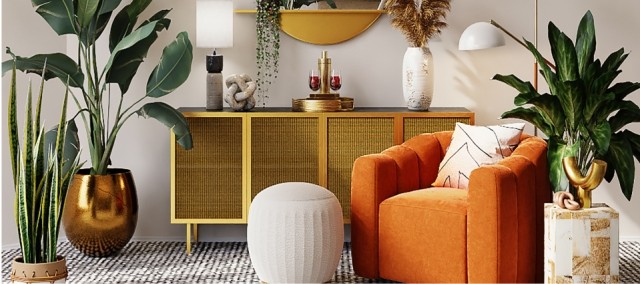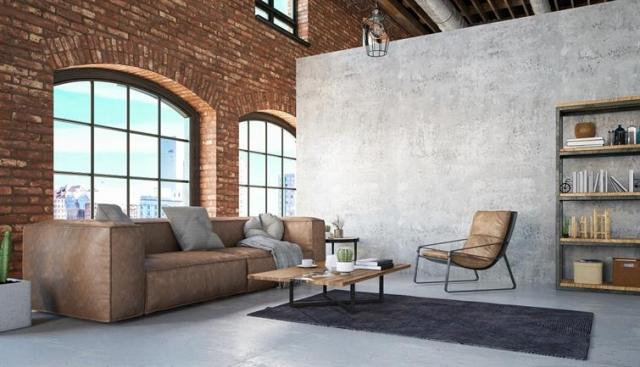If you've ever wondered, "What is a loft apartment," but didn't want to ask, here's your answer:
A loft apartment is a large, open space with very few (if any) interior walls and an open floor plan. It’s very similar to a studio apartment, as neither have a separate bedroom, but lofts tend to be much larger — 1,000-2,000 square feet, as opposed to a studio’s average of 600 square feet.
Lofts tend to have very high ceilings (about 10 feet) and tall windows. Traditionally, lofts are converted warehouses with exposed brick, pipes, and support beams, but modern lofts may not have those features. A loft apartment is different from an apartment with a loft. To cover all definitions, “loft” also means the space in a house just below the eaves (aka the attic). Confused? Let’s explore lofts. (It’s a lofty undertaking, for sure.)
This article will cover everything you ever wanted to know about lofts, including:
- The History of Loft Apartments
- Characteristics of a Loft Apartment
- Loft Apartment Pros and Cons
- The Difference Between a Loft and an Apartment with a Loft Space
- How to Decorate a Loft Apartment
- Loft vs. Studio
History of Loft Apartments
Imagine mid-19th century Paris. The Eiffel Tower was new, skirts were long, and hats were big. It was the world capital of fashion and art, and artists during this time were creating oversized, lavish masterpieces. These huge paintings required equally huge space to create them, which gave rise to expansive studios called ateliers, places where artists and aspiring artists lived and worked together.
The idea of a loft apartment didn’t gain traction in the US until the mid-20th century in New York City. It was then that artists started moving into abandoned warehouses so they could use these spaces as studios. At first, they were chased out by the fire department because the old warehouses were deemed unsafe, but eventually the artists were able to convince city officials to let them use the spaces. It didn’t take long for what began as a need for struggling artists to become a trendy living option.
Today, loft apartments have global appeal, celebrated for their history and for architectural features that make them unique. However, not every loft began as a factory or warehouse. As demand increased, builders began constructing apartments with certain loft-like features to satisfy demand.

Characteristics of a Loft Apartment
You’ll find some similarities and differences as you search for loft apartments. Usually, lofts have large, open floor plans and high ceilings. But even within the world of loft apartments, there are differences.
Hard Lofts
The term “hard loft” doesn’t refer to the flooring (although some are cement). The term “hard loft” refers to what is traditionally thought of as a loft space. This is the historic warehouse converted into apartments with exposed beams and ductwork, brick and support beams, and cement or hardwood floors (most often original). Warehouses converted into lofts often have unique features from the time period in which they were built, lending these spaces a rustic charm that many people find irresistible. Hard lofts have a “cool” factor long associated with those who live and work from their loft space, traditionally artists and musicians.
Due to the limited supply of hard lofts (there aren’t that many old warehouses waiting to be converted into apartments), new lofts are being built to meet demand. These new lofts are sometimes called soft lofts.
Soft Lofts
Soft lofts are newer constructions built to mimic that old-world industrial charm you’ll find in hard lofts. These apartments also provide high ceilings, large windows, and exposed brick. But unlike hard lofts, these apartments are designed to have these features, rather than the other way around.
Because they are newer, soft lofts offer some features you might not get with hard lofts. Soft lofts often have upgraded utilities and amenities, along with modern finishes and popular features. Because they are designed from the ground up, soft lofts tend to have community amenities like swimming pools and fitness centers as well.
You may find soft lofts offer more storage space since they are built specifically for residents, so you will likely have closets and maybe even a pantry. Because they are modern buildings, they tend to be better insulated than converted warehouses.
Loft Apartment Pros and Cons
Like most things, you’ll want to weigh the pros and cons when renting a loft. While there are several benefits, there are also some drawbacks. Here are some things to consider.
Pros:
- Ample Square Footage: Lofts typically provide significantly more living space compared to traditional apartments, allowing for greater flexibility in layout and design.
- Open Concept Layout: The combination of high ceilings and large windows creates a sense of freedom and airiness.
- Distinct Industrial Charm: Features like exposed brick walls and concrete floors give loft apartments a unique, stylish appeal.
Cons:
- Energy Efficiency Challenges: Older buildings may lack proper insulation, potentially leading to higher heating and cooling costs. This is especially true for converted industrial buildings since they weren’t intended as living areas. Lofts tend to have very high ceilings, and some have floor-to-ceiling windows, making heating and cooling these spaces a challenge.
- Decorating Challenges: The open floor plan and unique architectural features can make it difficult to define and decorate distinct living areas (more on that below).
- Limited Storage: Lofts often come with limited storage space, necessitating creative space management solutions.
The Difference Between a Loft and an Apartment with a Loft Space
So, what’s a loft space, then? Some apartments have lofts. These aren’t necessarily loft apartments (although they could be), but they make use of the space above your head by creating an elevated nook — or loft — that is accessed by a narrow staircase or a ladder.
The loft is usually above the main living area and is often open to the space below. A loft space typically has low ceilings (about four feet), but it is an ideal space for sleeping (usually with a low-profile bed or mattress). So, a loft is a space that is … aloft.
Loft spaces are popular in studio and micro apartments. Since a studio averages about 600 square feet and a micro apartment averages about 400 square feet, a loft provides a little extra living space for residents.

How to Decorate a Loft Apartment
Loft apartments have a utilitarian appeal to them, but those who have never lived in one may be surprised to find the space a little bit drafty. Those tall, metal-encased windows aren’t always well-insulated since this was a warehouse. It was designed to be a functional space, not a sophisticated housing option. But the tradeoff of having amazing natural light and fantastic views from those floor-to-ceiling windows is often worth it.
With its former life as a place where factory workers spent their days, lofts often lack storage. Unless closets were built into the space, you may find you have to get innovative. An open rack for hanging your clothes, for example, and using screens or area rugs to create separate living spaces.
With 10 to 20-foot ceilings, lofts have a lot of space above. As a result, if there are any walls, they likely don’t go all the way up. You may find that noise echoes throughout your loft, but some creative decorating should help combat that.
Some lofts may lack amenities that many apartment dwellers have come to expect, such as on-site fitness centers and swimming pools. Since they are usually located in once-industrial city hubs, many lofts lack the space for these features. Many loft dwellers are fine with this since these hubs are often the trendiest downtown locations, and they get to live in an area filled with shops, restaurants, art galleries, and nightlife.
Loft vs. Studio
If you are having trouble deciding between a loft and a studio, several factors may help you decide which to choose.
Lofts, especially hard lofts, tend to be more expensive because of their size, availability, and demand. Hard lofts have historical value, and they tend to be in highly sought-after neighborhoods. Since there are fewer available hard lofts, that will increase the price, as well. In addition to higher rent prices, you may find that cooling and heating a space with 10-plus-foot windows costs more than heating and cooling a 600-square-foot studio with standard ceilings and windows.
If you are looking for a small, cozy space, then a studio may appeal to you more than an open, airy loft. But if those soaring windows and industrial features are more your style, the extra costs associated with a loft may be well worth it.
FAQs
How is a loft different from an apartment?
Apartments are designed and build specifically for residential housing. Typically, a traditional loft is converted from a warehouse or other commercial building, many of which are historic.
Who likes living in a loft apartment?
People who appreciate the wide, open spaces, tall windows, and high ceilings might enjoy living in a loft. Artistic people or those who prefer a minimalist space tend to appreciate lofts, as well as those who like the historic aspect of loft buildings. Since lofts are often converted warehouses, they're often located in trendy downtown neighborhoods, appealing to those who want to live in the heart of the city.
Are lofts more expensive than apartments?
While much depends on location and other factors, lofts tend to be more expensive than traditional apartments due to the fact that they're more difficult to find. Since lofts are often converted warehouses, usually historic, there's a limited supply. They also tend to be located in downtown neighborhoods, which are often more expensive than suburban areas. Because of the high ceilings, tall windows, and lack of insulation, lofts also tend to come with higher utility costs.






